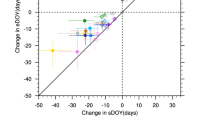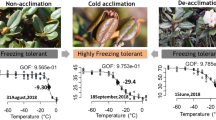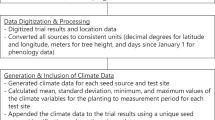Abstract
Background/Question/Methods
Climate change is resulting in warmer average temperatures in much of North America, leading to earlier flowering dates for most tree genera. However, earlier flowering dates can increase the chance of frost damage which may in turn reduce or eliminate seed and fruit production. This has important implications for both forest regeneration and the organisms which depend on these resources.Although specific examples, such as the “Easter frost” of 2007, show that frost damage can have extreme short term impacts on tree reproduction, we lack a general understanding of the frequency and importance of these events in non-agricultural contexts. Moreover, the magnitude by which climate change could increase these events is unknown.In this study we address the following questions: 1) How good of a predictor are environmental variables (such as temperature) for pollen release date and duration across multiple genera of North American trees? 2) How frequently and to what extent has frost damage affected pollen production over the last decade? 3) Based on temporal and spatial variation in environmental factors and tree pollen phenology, what can we predict for future decades?To investigate these questions we make use of a large pollen count dataset, derived from asthma related data collection efforts. This dataset consists of 55 urban sites across North America, and contains six years of data. Pollen was collected daily and identified to the genus level. We also make use of nearby municipal weather stations for detailed daily weather data.
Results/Conclusions
Certain genera, such as Acer, Alnus, Populus, and Quercus had relatively earlier pollen production times, putting them at higher risk of frost damage. Within each genus there was high variation in when the day of peak pollen counts occurred; for example Quercus peak days ranged from February 28th to June 7th. This variation was largely explained by environmental variables and site specific effects.We found many examples of days which had minimum temperatures sufficiently low to damage plant tissue but where pollen was still collected. For example, in the Quercus genus 223 out of 7417 pollen count observations fit these criteria, suggesting the importance of frost damage to this genus. Next, by comparing pollen count distributions between years, we show the extent to which frost damage has limited pollen production for multiple genera. Finally, we use hierarchical models to show how climate change may affect the impact of frost damage in the future.
Similar content being viewed by others
Article PDF
Author information
Authors and Affiliations
Rights and permissions
About this article
Cite this article
Katz, D. Frost and flowers: Predicting the effects of climate change on spring frost damage using a large pollen count dataset. Nat Prec (2010). https://doi.org/10.1038/npre.2010.5365.1
Received:
Accepted:
Published:
DOI: https://doi.org/10.1038/npre.2010.5365.1
Keywords
This article is cited by
-
Modeling uncertainty of statistical downscaling methods in quantifying the climate change impacts on late spring frost risk over Iran
Modeling Earth Systems and Environment (2018)



